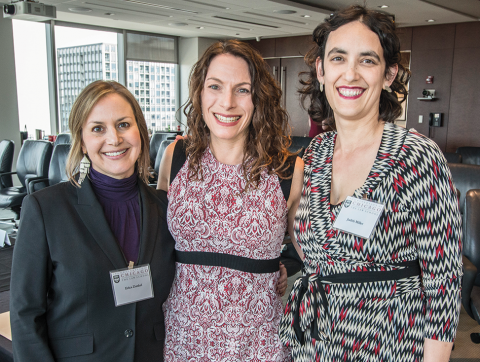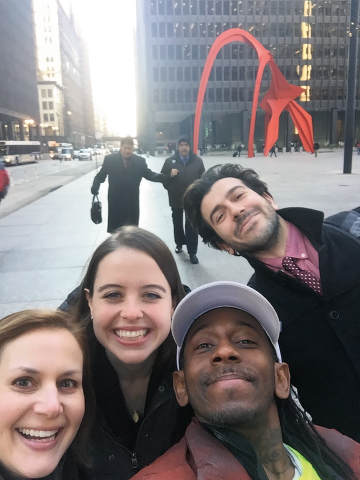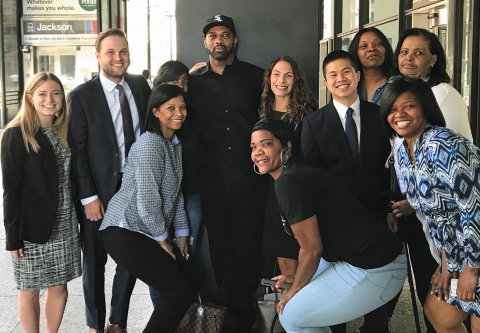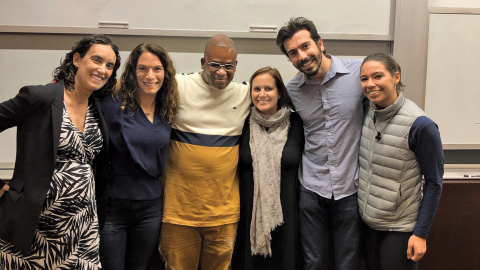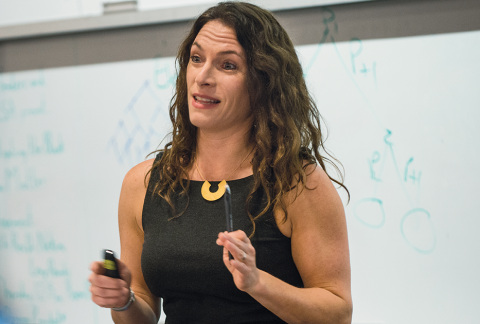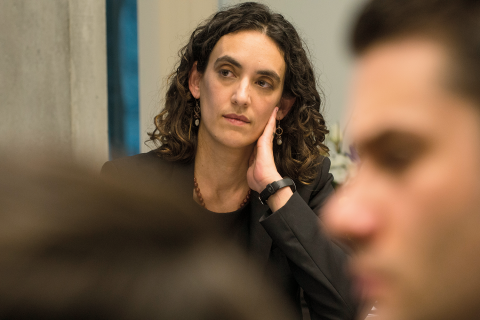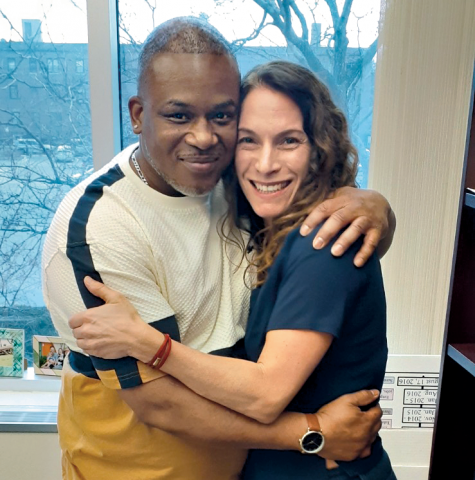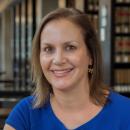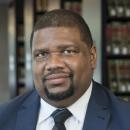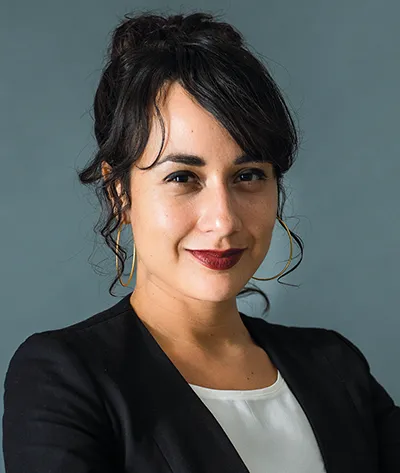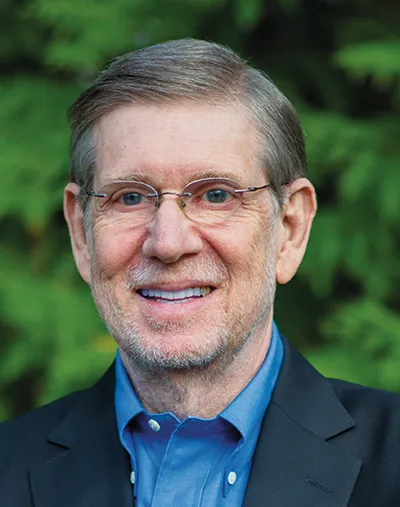Power in Numbers
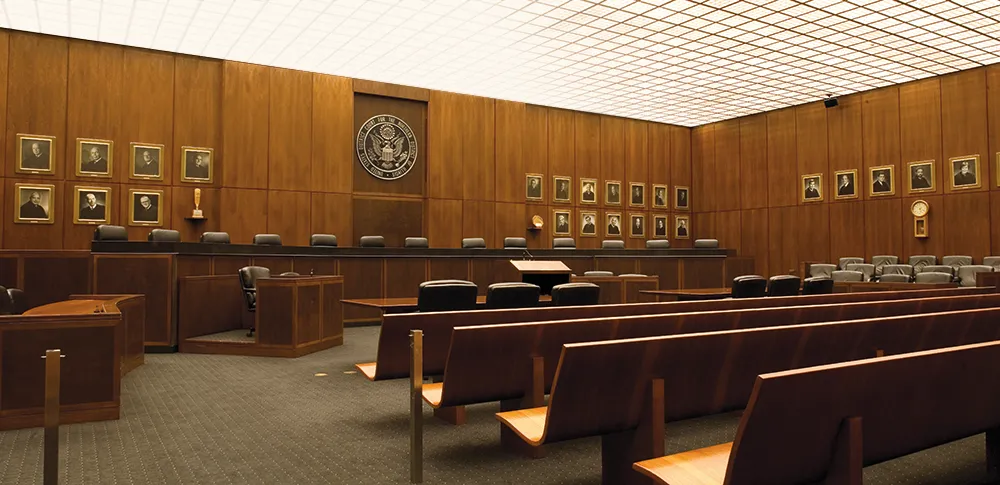
Walking into the ceremonial courtroom on the 25th floor of the Everett M. Dirksen US Courthouse on December 14, 2017, Linnet Davis-Stermitz, ’18, knew that the scene before her was exceptional, although it would take several years and two federal clerkships to understand just how exceptional.
Nothing she’d experience after graduation would resemble this two-day evidentiary hearing in downtown Chicago. Nothing in her professors’ decades of combined experience has ever compared, either.
First, there were nine federal trial judges at the front of the sprawling, wood-paneled courtroom named for James B. Parsons, ’49, and used for en banc sittings of the US Court of Appeals for the Seventh Circuit and other large or high-profile proceedings. Second, the judges were, at once, hearing evidence in 12 separate cases involving 43 defendants—a pivotal moment in the Federal Criminal Justice Clinic’s groundbreaking “fake stash house” litigation, a nearly five-year project spearheaded by Clinical Professor Alison Siegler, the clinic’s founder and director.
Third, the room was packed with journalists, family members of the defendants, two expert witnesses, and dozens of lawyers and law clerks—some of them linked to the case and some just there out of curiosity. Siegler and Davis-Stermitz were at a defense table with the clinic’s two other professors, Judith Miller and Erica Zunkel, and several other students. And then, sitting in the area typically reserved for jurors, were dozens of men accused of agreeing to rob nonexistent drug stash houses, crimes typically carrying mandatory minimum penalties of 15 to 25 years in prison. They were victims, Siegler and her team would argue, of federal Bureau of Alcohol, Tobacco, Firearms and Explosives (ATF) sting operations that disproportionately targeted people of color.
“We were alleging discrimination based on race,” Zunkel would later recall, “and I remember looking over at the jury box, at our clients who were all Black or Brown, and one of the judges saying, ‘Well, there’s Exhibit A right there,’ or something to that effect. It was a powerful image. The entire hearing was quite an experience—one of the most unique experiences of my career.”
Davis-Stermitz hadn’t interacted much with clients at this point in her education—although she would come to know one of the defendants, Leslie Mayfield, during his sentencing the following year—and seeing the men in the jury box that day felt “humbling and inspiring.”
“I just felt the weight of the project before us,” said Davis-Stermitz, who after graduation clerked on the US District Court for the Southern District of New York and the US Court of Appeals for the Ninth Circuit and is now a litigation fellow for Gupta Wessler. “All of it was extraordinary—to see the bench laid out for all the judges like it was the Supreme Court or an en banc oral argument … and to watch as all nine judges jumped in with question after question.”
The complex litigation project—which ultimately changed enforcement practices, set court precedent, and saved clients hundreds of years in prison—had defied expectations from the start. It deviated from the typical one-client, one-case model and instead took aim at systemic racism, combining a dozen separate cases and using statistical analysis to illustrate a pattern of discrimination. The hurdles were high: a never-before-met legal standard, difficult-to-obtain data, and a bid to convince the court to fund an empiricist who would serve as an expert witness on all 12 cases.
The years of painstaking work—hundreds of pages of briefs, thousands of hours spent combing through records—were punctuated by breathtaking turns and hard-fought achievements. There was Siegler’s oral argument before the en banc Seventh Circuit in 2015—and a subsequent ruling that made it easier to obtain discovery in support of racially selective law enforcement claims not only in the Seventh Circuit but, later, in the Third and Ninth Circuits as well. There were months of civil litigation to access Illinois State Police records, intense meetings with prosecutors, and in 2018—not long after the landmark evidentiary hearing—a judicial rebuke of the sting practice and a series of plea deals, sentencing hearings, and prison releases.
A pivotal early moment was a meeting Siegler and Miller called to convince other defense attorneys to let the clinic coordinate litigation across all of their stash house cases using a strategy so novel that Siegler coined a phrase to describe it. She called it a “criminal class action,” even though “class action” isn’t technically used outside civil litigation. It was a bold moment: Siegler and Miller, flanked by several students, standing at the front of a conference room in the federal defender’s office saying, “We want to do this thing nobody has done before, and we think we can win,” and the attorneys looking back at them, incredulous, saying, “But nobody ever wins race discrimination motions.”
Siegler laughed as she described it several years later. Gutsy asks were, in many ways, the project’s cornerstone, and this had been among the first.
“They looked at us like, ‘What are you talking about?’ There was a lot of doubt that we could do much of anything,” she said. “But their clients were looking at a lot of time. Eventually they all said, ‘OK, we’ll try your Hail Mary.’”
I remember looking over at the jury box, at our clients who were all Black or Brown, and one of the judges saying, ‘Well, there’s Exhibit A right there,’ or something to that effect. It was a powerful image. The entire hearing was quite an experience—one of the most unique experiences of my career.”
Erica ZunkelClinical Professor of Law, Associate Director of the Federal Criminal Justice Clinic
Years later—after that Hail Mary won dozens of men their freedom and accolades had begun rolling in—several things would become clear.
There’s power in numbers, in both the human sense and the statistical.
Criminal defense work, particularly within a law school clinic, can be a masterful driver of systemic change.
And what seems impossible sometimes … isn’t.
“We linked 12 different cases that all had the same claim, and it was much harder for the judges to dismiss us and say, ‘This is nonsense,’” said Miller, who joined the Law School in early 2014 just as the project was getting underway and became a key part of the team, ultimately supervising students and playing a lead role in aspects of the litigation. “The project worked because we hung together.”
Thinking back, Miller says she understood going in that there were steep climbs ahead and that overcoming them would be “a tremendously big deal.”
What she didn’t foresee was just how far the litigation would sprawl.
***
To understand why the clinic started down a path riddled with so many hard-to-clear hurdles, it’s important to know two things about Alison Siegler.
First, the longtime federal defender launched the Law School’s Federal Criminal Justice Clinic in 2008 with the idea that she wanted to change the way the criminal legal system treats people charged with crimes.
“And to do that I needed to go beyond individual representation and identify systemic crises and places where our client base is being harmed,” she said. “I often think, ‘How can I approach a particular problem in a way that doesn’t just fix the problem for one person but fixes it across the board?’ I’ll see a problem, think about a particular end result I want, and then try to conceptualize a way to get there.”
Of course, she added, “that’s when it becomes really terrifying because you have no idea if it’s ever going to work—you just have no idea.”
And this is the second thing to know: Siegler, Miller, and Zunkel have cultivated an ability to push through uncertainty, frustration, and fear of failure. That’s the secret—not seeing obstacles as endpoints.
Which is important because there were several developments that might have ended this project.
One occurred in 2015 after the Seventh Circuit’s en banc ruling in US v. Paul Davis, Jr., et al, the clinic’s first stash house case and the one that had inspired the project. The ruling set important precedent that would help future defendants but didn’t ensure discovery across all 12 cases as Siegler had hoped. For that, the defense team would need to return to district court and litigate individually in several of the cases.
“We didn’t have the time or the brainpower to go back to ground zero,” she said. “I was swimming laps early one morning, and I just kept thinking, ‘How are we going to get past this?’ and it just brought me to tears. I started crying right there in the pool.”
These were the kinds of pitfalls Siegler couldn’t have pictured a year and half earlier, when her friend and former colleague Matt Madden called to ask if the clinic wanted to help with the Davis appeal. He told her about the sting practice at the center of the case: ATF informants would approach an unsuspecting target with a story about a drug-filled stash house and then convince the target to help plan an armed robbery. Bring friends, bring guns, the informants would say. It’ll be easy money. The stash house, of course, would turn out to be fake—but the drug, gun, and robbery charges that resulted were both real and, given the large hauls promised by informants, significant. What’s more, Madden told Siegler, the case involving Paul Davis wasn’t a one-off—there were other fake stash house cases wending their way through federal district court in the Northern District of Illinois. Many of the defendants, he said, were people of color.
Siegler, intrigued, said she’d take the appeal in Davis, and she convinced her new hire, Miller, to start her job several weeks early to join the team. Miller, like Siegler and Zunkel, had worked as a federal public defender, and the broader issues around disparity and discrimination were ones she wanted to address. Changing her plans to get in on the ground floor was a no-brainer.
Later that year, after Siegler and Miller had finished briefing the appeal, they discussed how to get at the broader pattern. What if they joined forces with the other defense attorneys to prove a pattern of selective enforcement?
There were serious impediments, most notably the US Supreme Court’s 1996 ruling in US v. Armstrong. The Armstrong case made it so difficult to obtain discovery in support of a selective prosecution claim that, in nearly two decades, there had not been a single successful selective prosecution or selective law enforcement claim on the merits—and in only a handful of cases have defendants even been able to meet the Armstrong standard and gain discovery. That’s because the standard had created a catch-22, Siegler said, by requiring defendants to present “some evidence” to show both discriminatory effect and discriminatory intent. Demonstrating that people of a different race were committing the same offense but weren’t being charged (discriminatory effect) was extraordinarily difficult—and, without discovery, obtaining “some evidence” of prosecutors’ or police’s discriminatory intent was impossible.
“You had to show proof of discrimination to get evidence of discrimination,” Siegler said.
In Armstrong, defendants facing federal crack cocaine distribution charges had requested discovery to support a selective prosecution claim, and they had done so by presenting evidence that 100 percent of the people charged with federal crack offenses in Los Angeles were Black. The Supreme Court ultimately rejected the claim because those defendants failed to show that “similarly situated” people of other races had committed the same crimes without being charged. Of course, it is exceedingly difficult to determine the universe of individuals committing a certain type of crime without discovery, Siegler explained. For example, any information about people arrested but not prosecuted for crack crimes would be in the hands of prosecutors.
What’s more, in the years after Armstrong, courts had extended the standard to cover not just prosecutors but law enforcement—and meeting that standard for policing decisions is even more difficult, Siegler said. “First, it is impossible for a person of color to point to similarly situated white individuals who were not arrested because there is no record of such people,” Siegler wrote in a 2021 law review article. “Second, without discovery, a defendant cannot know what led the police to target him, so he cannot know who is ‘similarly situated’ to him.”
So she and Miller decided to find another way. They would distinguish the stash house cases from Armstrong by focusing on selective law enforcement (the ATF’s decisions to target certain individuals) rather than selective prosecution—and, ultimately, use statistics to meet the standard and show that the ATF had disproportionately targeted people of color. To do this, they would need to analyze two sets of data—a defendant group and a “similarly situated comparison group.” The strategy was ambitious: the team would need to identify other fake stash house defendants in the Chicago area; convince those defense lawyers to join the case; hire an expert witness to perform the analysis; find a way to pay the expert witness; obtain information on the ATF’s targeting criteria; identify a comparison group that met those criteria; collect arrest, conviction, and demographic data on the people in both groups—the list went on and on.
The clinic learned through the defense bar that 94 people had been charged in fake stash house cases in an eight-county area near Chicago between 2006 and 2013. More than 90 percent of them were people of color. Of those, 43 had pending cases and became part of the litigation. (There was another client at one point, but Miller said the judge forced a guilty plea by refusing to give him time to pursue the litigation, something she found “heartbreaking.” Other stash house defendants had already been convicted, and in 2019 Zunkel would launch a project to seek compassionate release for several, filing the first motions in early 2021.)
Once the clinic had convinced the other defense lawyers to join forces, the team hired Jeffrey Fagan, a Columbia Law professor whose work examining New York’s stop-and-frisk program helped make him a sought-after expert on policing. Since the clients were indigent, Chief Judge Rubén Castillo of the US District Court for the Northern District of Illinois agreed to appoint Fagan as the joint expert.
Soon, Siegler, Miller, and several of the clinic’s students were engaged in a tangle of efforts, including nine months of litigation in 2015 to subpoena data from the Illinois State Police about defendants in the “similarly situated” comparison group—292,442 people from the same eight-county area who met the ATF’s targeting criteria, in that they had sustained prior drug, gun, and robbery convictions between 2000 and 2015.
The clinic team was also litigating several of the individual cases and coordinating strategy with all of the other individual attorneys.
“We were constantly filing motions and litigating many different sub-issues that came up along the way,” Siegler said. “At times other lawyers would push back and question our approach to something. And we would need to break it down with them and talk it out and get everybody on the same page before we could move forward. It was complicated—we had a lot of different people to answer to.”
“One of Alison’s core strengths as a professor and a leader is her ability to constantly bring home the bigger importance of every little thing that you’re working on.”
Roisin Duffy-Gideon, ’18
Meanwhile, the appeal in Davis, the clinic’s original case, continued. In late 2014, a three-judge panel on the Seventh Circuit upheld a lower court decision granting discovery—but the government sought an en banc hearing, which was granted and scheduled for July 2015.
That spring, Miller worked with several students to prepare Siegler for the en banc oral argument, an “enormous” investment of time that paid off when Siegler stood up before the 10 judges to, among other things, lay out the distinction between a selective enforcement claim and a selective prosecution claim.
“We teach our students that it’s all about preparation, preparation, preparation—and that’s what we did,” Miller said. “It was one of the best appellate arguments I’ve ever heard. Alison was amazing.”
The Seventh Circuit’s opinion was a victory in the sense that it relaxed the legal standard for defendants seeking discovery from law enforcement agencies. The opinion paved the way for future selective enforcement claims in the Seventh Circuit and laid the groundwork for the Third Circuit’s 2017 ruling in US v. Washington and the Ninth Circuit’s 2018 ruling in US v. Sellers, each of which lowered the standard further by eliminating the “similarly situated” requirement and, in Sellers, the discriminatory-intent requirement. What the Davis ruling didn’t do, however, was directly provide the clinic team the documents they needed to move forward with all 12 motions to dismiss, including ATF manuals containing written policies on the selection and recruitment of individuals for the agency’s stash house program and other internal agency documents that would enable the team to identify the kind of “similarly situated” comparison group Armstrong appeared to require. These materials were essential to the expert report on which those motions would hinge, but the clinic team had only been granted discovery in some of the cases. Since the expert’s report would necessarily rely on and cite the internal ATF documents, the defense could only rely on that report in the subset of cases in which they had been granted discovery.
“We had this really strong opinion from the Seventh Circuit basically saying district court judges can grant a certain measure of discovery for claims of racially selective enforcement … and I’d thought, ‘Great, this means the government will let us use this discovery, which we already had in one district court case, across all the cases,’” Siegler said. “But then the prosecutors said we’d need to go back to district court … I hadn’t envisioned this roadblock that might derail the whole litigation.”
In the end, Siegler and her team refused to let it. First the clinic filed a motion asking Chief Judge Castillo to broaden the protective order governing the discovery in his case to enable the defendants in all 12 of the Chicago stash house cases to rely on the expert report. But Castillo denied that motion. To Siegler, this felt like a crushing and potentially litigation-ending defeat. There were a few tears in the pool, some heavy conversations among Miller, Zunkel, and their students—and then some determined problem-solving.
Finally, the team decided: if they couldn’t win by litigating, they’d negotiate. Siegler set up a series of meetings with the chief of the criminal division for the US Attorney’s Office, and she, Miller, and several students headed downtown with a message: withholding documents the defense has already seen—and that other defendants with nearly identical cases are allowed to use—will not play well with the public.
“I said, ‘If you think you have a good argument, fight me on the merits. Don’t fight me on a technicality,’” Siegler said. “It was intense. I don’t know which of our arguments really got through, but I felt the strongest was about optics: this will look ugly.”
The US Attorney’s Office ultimately agreed to let the team use the ATF manuals across the board, which would enable them to rely on Fagan’s report in every case.
***
Roisin Duffy-Gideon, ’18, spent the summer of 2016 immersed in those ATF manuals. She’d just finished her first year at the Law School and had taken a summer job with the clinic, which was in its third year of the stash house litigation.
The clinic team had made a lot of progress. In addition to securing the manuals, they had successfully forced the Illinois State Police to turn over data about the “similarly situated” group of 292,442 individuals who had been convicted of offenses the ATF claimed to be targeting.
The team now had information on the defendant group, which was 78.7 percent Black, and the comparison group, which was 55.4 percent Black, and they were preparing to file Fagan’s report in September. The results were compelling: When Fagan performed regression analyses to control for race-neutral variables such as geography and criminal history, he found an approximately zero percent likelihood that the racial disparity was due to chance.
That summer, Duffy-Gideon worked closely with Miller to answer another set of questions: how often had the ATF veered from its internal criteria when targeting people of color, and how often had it veered when targeting White people? Meticulously, she and Miller compared the manuals to investigation records, ultimately concluding that the ATF failed to follow its own criteria when recruiting Black people but followed it closely when recruiting White people.
It was painstaking work, but Duffy-Gideon remained focused, and Siegler helped with that—she was determined to keep everyone’s eyes on the prize.
“One of Alison’s core strengths as a professor and a leader is her ability to constantly bring home the bigger importance of every little thing that you’re working on,” said Duffy-Gideon, who would go on to clerkships on both the Northern District of Illinois and the First Circuit and now practices at Miner, Barnhill & Galland in Chicago. “In the course of any litigation there’s work that feels dull … but Alison was able to make very clear at each stage how the work we were doing would affect our clients.”
That September, the clinic and its partners filed the first of 12 motions to dismiss, each alleging that the ATF had unconstitutionally discriminated on the basis of race in violation of Equal Protection principles. At the center of each motion were data showing the disparity between the defendant group and the comparison group, Fagan’s expert report ruling out race-neutral explanations in the ATF’s targeting choices, and evidence showing that the ATF had departed from its own criteria when targeting people of color—all elements, the team argued, that demonstrated both discriminatory effect and discriminatory intent.
That academic year was a swirl of activity. Adam Davidson, ’17, who joined the clinic that fall, spent time on a successful request for additional expert-witness funding as well as a variety of research projects, including ones that required him to dig into Fagan’s report.
“Jeff Fagan was good at helping to translate the statistical analyses into what was happening in the real world,” said Davidson, who now teaches legal research and writing as a Bigelow Fellow at the Law School. “And when you start to do that you can—and this is thinking like a lawyer—step back and say, OK, here’s a logical inconsistency in your analysis, or here’s where there’s a hole that we have to plug either with legal analysis or more statistical analysis, or here are just facts that we don’t know or that we don’t have. So it was about getting to that point and stepping back from the in-the-weeds of how the regressions work to here’s the logic underlying why these [law enforcement] aggressions are happening.”
Davidson spent a lot of time making connections among all the cases, but he also worked to see each client as a separate person.
“The thing that we always tried to keep our eye on was that each person has his own story—each case had the same core, but slight differences,” Davidson said. “What we found was that by keeping our eye on that sort of individuality, it illuminated the similarities.”
Those similarities, of course, went to the heart of the litigation—and when the time came to present evidence to support the motions to dismiss, Siegler, Miller, and their team made yet another gutsy ask.
They wanted one evidentiary hearing for all 12 cases—not only to save time but to link the cases in each of the nine judges’ minds.
“The way I argued this idea was pure UChicago—it was all about efficiency,” Siegler said. “I said, ‘Let’s make it simple.’ It was a crazy idea, but we needed this to be different from what had ever been done before—we needed to get the judges’ attention. We needed every judge to know about every case.”
Together, the fake stash house cases told a story—and, according to Fagan’s analysis, so did the data.
The numbers, Siegler believed, were on their side, and when the judges agreed to proceeding with a joint hearing for all 12 cases, it felt like another step closer to change.
***
The joint evidentiary hearing took place shortly after the students finished their fall quarter finals and about six weeks after Miller, who had recently given birth to her first child, returned from maternity leave.
“There was no easing into it,” Miller said. “It was sort of trial by fire as a mother and a trial attorney. I remember that … over lunch breaks, in the middle of this incredibly intense experience, I would be in [a private room] pumping, with my phone on speaker so I could participate in the meetings the team was having.”
The students were equally focused as the hearing approached: Duffy-Gideon recalls pausing her clinic work briefly for finals and being envious of classmates who finished their exams earlier in the week. She had a serious case of, as she puts it, “FOMO” (fear of missing out), and when her last exam ended, she raced back to the clinic to pick up where she’d left off.
“The students were working 12, 13, 14 hours a day,” said Zunkel. “Their dedication was just phenomenal.”
Some students even changed plane tickets so they could stay in Chicago until after the hearing, and when the big day arrived, they were “center stage with us in the middle of the ceremonial courtroom,” Miller said, swelling with pride as she described her students gathered at counsel table.
The students and their professors arrived ready, having spent hours and hours studying not only two reports by Fagan but also a response report by the prosecution’s witness, Max Schanzenbach, a Northwestern Law professor. The prosecution denied that the stash house defendants had been racially profiled—saying instead they’d been chosen because of previous crimes—and they took issue with elements of Fagan’s report. To respond, Siegler, Miller, Zunkel, and their students all needed to understand the methods behind each report—and the documents “were long and dense and hard,” said Siegler, who direct-examined Fagan. “This was the most complicated direct or cross examination preparation I’ve ever done in my life.”
The hearing itself was energetic, with judges jumping in so often to ask questions that it sometimes was hard to keep track of the visuals.
“I had my direct examination of Fagan carefully organized into chapters with slides from the reports accompanying every question, but I began questioning Fagan and it was crazy—one of the judges just stepped in and started asking him questions herself, and then one of the other judges started direct examining him,” Siegler said. “We were jumping around from slide to slide, totally off track from where we’d been prepared to go.”
Duffy-Gideon’s job was to help prepare Miller’s cross examination of Schanzenbach—a process that required her not only to grasp the report, but also to learn to draft a cross examination. Davis-Stermitz was part of the team working with Zunkel to prepare Fagan for cross examination—reading through the reports and identifying vulnerabilities.
She was also in charge of operating the visual presentation software during Miller’s cross examination of Schanzenbach, which required Davis-Stermitz to not only learn the software but to know Miller’s cross examination thoroughly.
“Judith needed different documents to appear on the screen throughout her cross, and so I basically needed to train myself to become an additional limb,” Davis-Stermitz said. “I had to be able to anticipate where she was going and be ready to tweak.”
The preparation paid off all around—Davis-Stermitz deftly followed Miller’s lead, and Miller delivered a cross examination that Siegler later called “masterful.”
“It truly was one of the best cross examinations I have seen,” Siegler said.
When it was all over, Davis-Stermitz wasn’t sure what to expect, but she walked out “thinking we’d brought a really good fight.”
About two months later, in February, before any of the judges had ruled in the individual cases, prosecutors announced that they would drop all of the charges with mandatory minimums if the clinic’s clients would plead guilty and walk away from their racial discrimination claims. Chief Judge Castillo said he still planned to rule on the issue of racial bias in the two cases over which he was presiding.
In March, Castillo issued a 73-page ruling that called for the end of fake stash house cases, saying that they “have served to undermine legitimate law enforcement efforts in this country” and should be “relegated to the dark corridors of our past.” He stopped short, however, of dismissing the charges.
Ultimately, Siegler said, the ATF in Chicago stopped creating fake stash house stings and the US Attorney’s Office in Chicago entirely stopped bringing stash house cases.
In the months that followed, the defendants accepted the proffered plea deals and most were sentenced to time served and released having served fewer than three years behind bars. The difference was huge: stash house defendants who had been convicted before the litigation began were serving sentences of between 15 to 35 years.
For Davis-Stermitz, this phase was the crowning moment of the experience: she and a classmate, Jack Corfman, ’18, were assigned to client Leslie Mayfield’s sentencing under the supervision of Zunkel and James DuBray, ’14, a clinic alumnus who joined the team for seven months in 2018. In June 2018, about a week after their Law School graduation, Davis-Stermitz and Corfman stood up in court and helped convince US District Judge Edmond Chang to sentence Mayfield to time served—an experience that Davis-Stermitz calls “the most meaningful thing I’ve ever been a part of.”
Within the week, Mayfield—a man who had mentored and tutored other incarcerated people during his time in jail—was free, although prosecutors had been asking for him to spend three more years behind bars.
“I remember giving Leslie a really big hug after the judge announced the sentence,” Zunkel said. “And it was just incredibly joyous for me, as Jack and Linnet’s supervisor, to see their pride in what they had done. It was right around the time of their graduation, and they had worked so hard, and seeing the result was amazing. I was just so proud of them.”
These were the kinds of outcomes that had kept Davidson—who graduated before the evidentiary hearing—and others going during various points over the years.
“When I’d be slogging through things, and hitting my head against the wall, I’d think, ‘Yeah, it’s hard to be on Westlaw at 1 in the morning, but it’s not nearly as hard as not having your father at home or being locked in a cell,’” he said.
In the aftermath, Zunkel began advocating for post-conviction relief for several stash house defendants who had been convicted before the litigation, using the 2018 First Step Act’s compassionate release provision, which enables federal judges to grant reduced sentences for “extraordinary and compelling reasons.” In early 2021, she and a team of students filed lengthy motions for compassionate release on behalf of two pre-litigation stash house defendants who were sentenced to 25 years—sentences that would likely be lower today because of sentencing reforms to federal drug laws. In another case, the team filed a Seventh Circuit appeal on behalf of another pre-litigation stash house defendant, arguing that his 25-year sentence was unlawful because he was innocent of the sentencing enhancement the judge imposed. When this issue of the Record went to press, Zunkel was preparing to file a compassionate release motion on his behalf.
“These are people who were left behind because they had the bad luck to have been convicted early,” Zunkel said. “Had their cases been pending a little bit longer, they would have had the opportunity to join our litigation and get time-served sentences like our other clients. Instead, they’re serving long mandatory minimum sentences while others are free. That’s not justice.”
Siegler said that when COVID-19 hit, Zunkel not only sought relief for pre-litigation stash house defendants but became a national leader on compassionate release litigation, filing hundreds of pages of cutting-edge motions on a very tight timeline.
“It is a tremendous credit to Erica’s ingenuity, dedication, and leadership that every client she and her student team filed compassionate release motions for during that time was set free,” she said. “Erica is now wielding the same expertise to rectify the injustice done to those consigned to decades behind bars for a policing tactic—fake stash house stings—that has since been discredited and abandoned.”
“It was extraordinarily powerful finally to be able to walk into court and say, ‘Our clients should not be prosecuted because the government discriminated on the basis of race.’ We showed what was possible, and we opened up an avenue for challenging these racially discriminatory practices."
Judith MillerClinical Professor of Law
During and after the litigation, the clinic earned several awards for their work, including the Seventh Circuit Bar Association’s 2016 Justice John Paul Stevens Award for Outstanding Public Service Work for Siegler and the 2020 Clinical Legal Education Association Award for Excellence in a Public Interest Case or Project for the Federal Criminal Justice Clinic. Siegler also teamed up with then-student William Admussen, ’20, to write a Northwestern University Law Review article about the new legal standard, “Discovering Racial Discrimination by the Police.” In it, they argued that state courts, which hear the vast majority of criminal cases, and other federal courts should follow the Seventh, Third, and Ninth Circuits in creating lower discovery standards in selective law enforcement claims. It was the first article to describe what Siegler has called as an “important development in equal protection jurisprudence.”
In a hearing before a US House of Representatives subcommittee in March 2021, Siegler, Zunkel, and Miller submitted a statement arguing for comprehensive reforms in drug enforcement and policy, many connected to the racial disparities highlighted by the stash house litigation. Among their proposals: legislation to disincentivize federal law enforcement agencies and US Attorney’s Offices from running fake stash house operations and other reverse sting operations.
“Our fight in the courts was a form of criminal impact litigation—a way of advocating to change one part of the federal criminal system,” Miller said. “Getting Congress’s attention and contributing to a comprehensive legislative reform could produce impacts far beyond what any one case can accomplish.”
She added, “transforming a single case into sweeping litigation and now congressional testimony is one of the great privileges of working in the clinic with Alison, Erica, and the many generations of clinic students who fought alongside us.”
For Miller, the project was a chance to shine a light on the inequities that have driven her work for years.
“Many of us who work in the criminal system believe, and know, that there’s systemic racism permeating throughout, but … the courts have created doctrines that make it difficult to talk about race in any kind of clear, meaningful way,” Miller said. “It was extraordinarily powerful finally to be able to walk into court and say, ‘Our clients should not be prosecuted because the government discriminated on the basis of race.’ We showed what was possible, and we opened up an avenue for challenging these racially discriminatory practices. Especially right now, when there’s so much focus on race and the criminal legal system, I am really proud to have been a part of that.”
Looking back, Siegler is proud not only of how the litigation changed enforcement practices, discovery standards, and their clients’ lives, but what it taught the many students who worked on the project over several years.
“I often tell students that the main quality that I bring to cases is tenacity and an unwillingness to give up and give in,” Siegler said. “They saw not only the start and the end of the fight, but what happens in the middle when the turf gets rocky and we’ve lost our footing. I would tell them that when it feels like you’ve hit an impasse you just have to figure out a better way and keep moving ahead.”
Siegler paused.
“We started this litigation having no idea if we’d get to where we needed to go,” she said. “But we just kept putting one foot in front of the other down the path. And here we are.”
